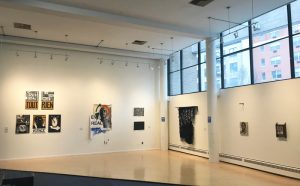
Curated by Codify Art – http://codifyart.com/
Dates: April 12 – June 2
Translating Histories draws from historical revisionism to examine how symbols are translated, codified, and questioned across time. Both past events and imagined futures are denatured across multiple retellings, like a game of Telephone where each recipient passes the narrative through their own filters, whether personal or hegemonic, creating increasingly specific interpretations in the process. At each nexus, the listener becomes the teller. The four artists in “Revision: Translating Histories” engage with cultural ancestries ranging from Haitian migration and Yoruba beliefs to the everyday mythologies of good luck charms and barber capes to craft contemporary portraits of deep-rooted canons.
Artists: Nathalie Jolivert, Aqeel Malcolm, Oluseye, Shaina Yang
Oluseye (Nigerian-Canadian, b. 1986) lives and works between Toronto, Canada and Lagos, Nigeria. Central to his practice is the male form, which he engages as the locus for his intersectional exploration of identity, value, sexuality, existentialism and spirituality. Aesthetically and conceptually, Oluseye’s work is informed by Yoruba culture—its sculptures, mythology, beliefs and even the angular facial features of its people. Using acrylic, pastel, collage and photo transfer, he creates layered portraits that are inspired by Yoruba terracotta heads and contemporary black male photography; the hybridity resulting in portraits that thread together the physical and the spiritual. Oluseye has exhibited at The Art Gallery of Ontario, Gallery 151 in New York, School 33 Art Center in Baltimore and Art Twenty-one in Lagos, Nigeria. He is a recipient of the Canada Council for The Arts New Chapter Grant.
Shaina Lee-Shuan Yang, often known as Aniahs Gnay, is a multidisciplinary visual artist and arts organizer based in NYC. Their work explores the relationships of the vessel body and its carried symbols, connectivity, and the space between it all. Yang is influenced by the superstitious nature of their Taiwanese family and life as a queer first-generation American, reflecting on the spaces and rituals created by the community and the definition of what it means to be invisible or visible. Yang looks at the space between all things to understand this shared experience of existence, and ultimately to question both the states of infinite solitude and infinite connection.